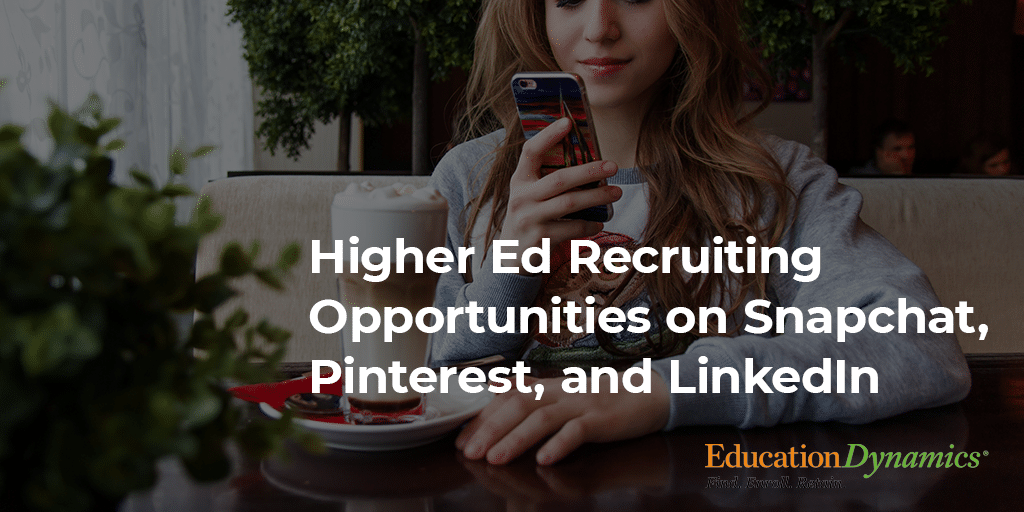Higher Ed Recruiting Opportunities on Snapchat, Pinterest, and LinkedIn

Pew Research Center, YouTube, Facebook, and Instagram continue to occupy the top three spots for American’s social media use. But what about those ranking further down the list? Twenty-nine percent of all Americans report using Pinterest, and 27 are using Snapchat. Twenty five percent are on LinkedIn. These figures represent millions of people. What opportunities exist for higher ed professionals looking to recruit students on these social media platforms?
EducationDynamics has years of industry-leading experience connecting colleges to students and creating valuable inquiries through social media marketing.
Snapchat for Higher Ed
Let’s look at Snapchat first. Even though it’s the fifth most popular platform, it’s popular among teens, with 88 percent using the app and often checking their accounts an average of six times per day. More colleges are turning to Snapchat to meet these prospective students where they are. Snapchat is an ideal platform for introducing your institution to prospects in a friendly and engaging way.
Research shows that 10-second micro-videos work best on Snapchat, though some users produce longer-form content that lasts up to 60 seconds.
This might sound short to a generation raised on 30-minute TV shows, and Snapchat’s answer is to let users build “stories” that are a series of shorter videos. The platform is also a great way to keep both prospective and current students engaged by sharing news and campus events. As a visual platform, Snapchat lets users add an artistic touch to their videos, with emojis, text overlays, stickers, and more. Engaging Snapchat stories use all the above, while also keeping their stories brief and to the point. With so many users and so many options, colleges need to be targeted in their use of Snapchat to make an impact and build an audience.
Pinterest rose to prominence in 2010 when it emerged as a way to build visual collections of everything from summer outfits to kitchen remodeling ideas. As of 2018, more than 175 million people use Pinterest worldwide. Importantly for colleges, 36 percent of people between 18 and 29 have Pinterest accounts. Since Pinterest is based on photography and visuals, there’s lots of overlap with Instagram, but Pinterest gives colleges unique opportunities for engagement. Each pin (aka a post) includes a link to a specific website, which makes it an excellent driver of traffic. Pinterest also uses an algorithm similar to Facebook to determine the quality of pins and rank which pins shows up in its users’ feeds. Colleges need to be using high-quality graphics and posting regularly to their Pinterest accounts (ideally two to three times per week) to increase engagement. Pinterest pins capture users’ attention best when they’re part of a collection or story, instead of a random assortment of images. Photos that tell the story of a graduation ceremony or ideas for decorating dorm rooms make great Pinterest Topics. Another bonus for higher ed users: Since pins must include links, photos or graphics, and a short description, Pinterest is very SEO friendly, and a good Pinterest collection can rank highly in search results.
LinkedIn Marketing for Higher Ed
LinkedIn is a social network for professionals who want to build business networks and improve their personal brands. Understandably, most colleges are focusing their LinkedIn use on their alumni chapters, but there are plenty of opportunities to connect with prospective students too. LinkedIn has 133 million users in America and 34 percent of people between 18 and 29 use the network. The site even has as an entire subdomain aimed at students with university.linkedin.com. Big numbers of students are using the site to set up their professional profiles in hopes of landing jobs after graduation. Colleges can leverage this momentum to connect with prospects and express their institution’s return on investment by showcasing alumni achievement and giving prospective students a glimpse at their potential careers.
By creating an active presence on Snapchat, Pinterest, and LinkedIn, you can connect with prospective students in unique ways.